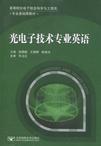光电子技术专业英语
出版时间:2010-9 出版社:北京邮电大学 作者:徐朝鹏//王朝晖//焦斌亮 页数:298
前言
光电子技术专业英语是继大学基础英语之后为提高光电子各专业学生读写英语文献的能力而开设的专业必修课,是大学阶段学习英语以及专业课的重要环节。通过本课程的学习,可以进一步增进学生对专业英语词汇、语法和结构的了解,增强学生对科技论文的写作能力,为将来从事光电子领域英文资料的查阅、翻译和写作打下坚实的基础。 在高等教育面向21世纪的改革中,学生基本素质和实际工作能力的培养受到了空前重视,国家教育部也提出要培养创新式人才。对于非英语专业的学生而言,学好英语,尤其是专业英语,是获取专业信息、掌握学科发展动态、参加国际间学术交流的基本前提。可见,英语水平和能力的培养不仅是文化素质的重要部分,在很大程度上也是能力的补充和延伸。在此背景下,教育部制定了有关规范,使外语教学更加受到重视。教材是教学的基本要素之一,特别是国家对学科进行调整之后,光电子等交叉学科专业的出现和发展,使专业英语的教材缺乏问题显得尤为突出。 考虑到专业英语一般在大三上学期开设,学生刚开始接触专业课,所以本书的专业内容定位在专业教材和科普读物之间,即不是用原版英语教材进行专业课教学,而是用英语介绍广泛的专业内容和知识。从专业的角度看,本书可称做“光电子技术概论”。 光电子学是发展十分活跃,又尚未完善的一门学科。作者在汇集国内外学者的研究成果和总结作者若干年的教学与科研工作的基础上,编写了这本教材,力求做到:基本概念清晰,基本内容深入浅出、易于理解。既有基本原理的阐述和必要的理论知识分析与讨论,也有典型应用事例、国内外近期发展状况与趋势。希望在有限的篇幅里让读者对电子与光电子领域的基本原理、主要知识体系及应用能够有所了解和掌握。同时每章还对重点词汇和疑难句进行了解析,并为词汇标注了音标,以方便读者阅读。 本书内容丰富,选材合理,涵盖光电子学基本理论和实际应用两部分内容。这两方面无所偏重,基本平衡。在基础部分,介绍了半导体物理、电磁场与电磁波、光学原理、激光原理、非线性光学等学科的基础知识;在应用部分,既介绍了“集成电路”这样目前广泛应用的高新技术,又介绍了“体全息存储”、“光镊”、“光子晶体光纤”这样的前沿题目,还涉猎到了“星间链路”这样的光波技术应用的核心领域。通过阅读本书可使读者在不知不觉间进入到光电子学研究的前沿。
内容概要
本书是光电子技术方面的专业英语教材。本书主要介绍了科技英语的特点、翻译方法和技巧,半导体物理和器件,电磁场和电磁波,光学原理,激光原理,非线性光学原理,集成电路制备,光通信,全息数据存储,光镊,光子晶体光纤,科技文献检索以及英语科技论文写作等内容。每一章分别从基本概念、原理;分类、技术优势和挑战等方面对现有的光电子技术进行阐述。 本书可作为高等院校电子科学与技术、光学工程、光信息科学与技术、光学等专业的本科生以及研究生的教材和参考书,也可作为非光电子类读者了解光电子学基本知识的参考书,还可作为读者投稿国际光电子类学术期刊的“投稿指南”。
书籍目录
第1章 科技英语翻译技巧 1.1 科技英语概念 1.2 科技英语文体总貌 1.3 科技英语词汇特点 1.4 科技英语翻译方法和技巧 1.4.1 科技英语翻译标准 1.4.2 科技英语翻译过程中语法特点 1.4.3 科技英语的翻译方法与技巧 1.5 提高科技英语翻译能力的途径 第2章 semiconductor physics and device 2.1 semiconductor materials 2.2 type of solids 2.3 crystal structure 2.4 the atomic structure of semiconductors 2.4.1 electron shells and orbits 2.4.2 valence electrons, conduction electrons, and ions 2.4.3 metallic bands 2.4.4 covalent bonds 2.4.5 electrons and hole current 2.5 the pn junction 2.5.1 doping 2.5.2 the pn junction 2.5.3 the depletion region 2.6 biasing the semiconductor diode 2.6.1 forward bias 2.6.2 reverse bias 2.6.3 peak inverse voltage (piv) 2.6.4 reverse breakdown 2.7 semiconductor device-bjt and fet 2.7.1 bipolar junction transistor 2.7.2 field-effect transistor 2.8 semiconductor applications 2.9 semiconductor competition 第3章 electromagnetic field and electromagnetic wave 3.1 the concept of electromagnetic fields and waves 3.2 history of electromagnetic wave 3.3 basic laws of electromagnetic theory 3.3.1 faraday's induction law 3.3.2 gauss's law-electric 3.3.3 gauss's law-magnetic 3.3.4 ampere's circuital law 3.3.5 maxwell's equations 3.4 properties of electromagnetic wave 3.4.1 wave model 3.4.2 particle model 3.4.3 speed of propagation 3.5 electromagnetic spectrum and applications 第4章 fundamentals of optics 4.1 a brief history about optics 4.1.1 the views of the antique philosophers 4.1.2 classical optics 4.1.3 modern optics 4.1.4 moving bodies optics 4.2 contents of optics 4.2.1 rectilinear propagation of light 4.2.2 reflection and refraction 4.2.3 interference and diffraction 4.3 optics systems 4.3.1 telescopes 4.3.2 retinal acuity 第5章 fundamentals of lasers 5.1 definition of laser 5.2 a brief history of laser 5.3 principle of laser generation 5.3.1 spontaneous and stimulated emission, absorption 5.3.2 the laser idea 5.3.3 pumping schemes 5.4 structure and properties of laser 5.4.1 structure of laser 5.4.2 properties of laser beams 5.5 lasers types 5.6 application of laser 5.6.1 industrial applications 5.6.2 medical applications 第6章 nonlinear optics 6.1 definition of nonlinear optics 6.2 history of nonlinear optics 6.3 features of interaction of intense light with matter 6.4 theory framework of nonlinear optics 6.5 descriptions of nonlinear optical processes 6.5.1 second-harmonic generation 6.5.2 frequency mixing generation 6.5.3 sum-frequency generation 6.5.4 difference-frequency generation 6.5.5 optical parametric oscillation 6.5.6 third-order nonlinear optical processes 6.5.7 intensity-dependent refractive index 6.5.8 third-order interactions 6.5.9 parametric versus nonparametric processes 6.5.10 saturable absorption 6.5.11 two-photon absorption 6.5.12 stimulated raman scattering 6.6 application and outlook 第7章 integrated circuit fabrication 7.1 the concept of integrated circuit 7.2 history of integrated circuit 7.3 integrated circuit fabrication 7.3.1 integrated circuit design 7.3.2 the manufacturing process 7.4 application 7.5 the future 第8章 optical communications 8.1 the system model 8.2 optical transmitters 8.3 the transmitted optical field 8.4 stochastic fields 8.5 the optical channel 8.5.1 the unguided (space) channel 8.5.2 the guided (fiberoptic) channel 8.6 the detected optical field 8.7 background radiation 8.8 photodetection 8.9 optical intersatellite links 第9章 holographic data storage 9.1 the concept of holography 9.2 history of holographic data storage 9.3 principle of holographic data storage 9.4 theory about formation and reconstruction of a hologram 9.4.1 volume grating and bragg diffraction 9.4.2 born's approximation 9.4.3 coupled wave theory 9.5 hardware for holographic data storage 9.6 coding and signal processing 9.6.1 binary detection 9.6.2 interpixel interference 9.6.3 error correction 9.6.4 predistortion 9.6.5 gray scale 9.6.6 capacity estimation 9.7 associative retrieval 9.8 recording materials 9.9 two-color or photon-gated holography 第10章 optical tweezers 10.1 concept of optical tweezers 10.2 history of optical tweezers 10.3 basic theory of optical tweezers 10.4 system of optical tweezers 10.5 application of optical tweezers 10.6 future of optical tweezers 第11章 photonic crystal fiber 11.1 the origins of pcfs 11.1.1 conventional optical fibers 11.1.2 photonic crystal 11.1.3 from conventional optical fibers to pcfs 11.2 the history of pcfs 11.3 guiding light in pcfs 11.3.1 modified total internal reflection 11.3.2 photonic bandgap guidance 11.4 properties of pcfs 11.4.1 solid core pcfs 11.4.2 hollow core pcfs 11.5 fabrication of pcfs 11.5.1 stack-and-draw technique 11.5.2 extrusion fabrication process 11.6 application of pcfs 11.6.1 high power and energy transmission 11.6.2 fiber lasers and amplifiers 11.6.3 gas-based nonlinear optics 11.6.4 supercontinuum generation 11.6.5 telecommunications 11.6.6 optical sensors 11.6.7 gratings in pcf 11.7 future perspectives 第12章 科技文献检索 12.1 信息检索的含义 12.2 信息检索的基本原理 12.3 检索语言 12.4 文献检索工具 12.4.1 检索工具应具备的条件 12.4.2 检索工具的类型 12.5 检索文献资料的途径 12.6 文献检索的基本方法 12.7 文献检索的一般步骤 12.8 文献数据库检索 12.8.1 检索工具的类型 12.8.2 国内主要资源 12.8.3 国外主要资源 12.8.4 进人数据库的方法和思路 12.9 其他检索文献途径 第13章 英语科技论文写作 13.1 科技论文的概念和特点 13.2 如何撰写英语科技论文 13.2.1 构建论文写作提纲 13.2.2 撰写英语科技论文 13.3 英语科技论文的写作技巧 13.4 投稿过程 13.5 论文发表后的工作 附录a 常用前缀、后缀和构词成分 附录b 常用数学符号及数学式表达 附录c 常用的符号和单位 c-1 si base units c-2 si prefixes c-3 directly derived unit c-4 special names of derived unit c-5 units to be discouraged or abandoned c-6 some physical constants 附录d sci收录的光电类期刊 d-1 530物理学 d-2 537光学 d-3 539应用物理学 d-4 730电工与电子技术 d-5 736电子技术 附录e 2009年ei收录的中国科技期刊(光电类可投期刊)
章节摘录
科技英语大量使用专业词汇和半专业词汇。专业词汇是指仅用于某一学科或专业的词汇或术语。每门学科或专业都有自己的一套含义精确而狭窄的术语。从词源角度来分析,专业词汇主要有两个来源,一个是来自英语日常词汇,另一个是来自拉丁语和希腊语词根及词缀的词汇。 1.日常词汇 用于某一专业科技领域便成为专业技术用语,具有严格的科学含义。例如,mask在日常生活中表示“面具,掩饰”,被光电领域借用后表示“掩模”;gray在日常生活中表示“灰色的”,被纺织业借用后表示“未漂染的,本色的”。借用日常词语表达专业技术概念,在语义学上属于以联想建立词义理据,即以引申或扩展的基本词义来给新的概念命名,符合英语一词多义和词性转化的历史传统。 2.加缀词 除部分来自英语日常词汇外,绝大多数,尤其是名词术语则是由拉丁语和希腊语的词根(root)和词缀(affix)构成的。现以前缀hyper-(超出,过度,在……上)和后缀-asis(或-osis)(表示疾病)分别举例如下: hyperacid胃酸过多的;酸过多的 hyper focal distance超焦距 psychosis精神病 词根是英语词汇的基本组成部分。绝大多数的自由词根来源于古英语,这类词根在各类词素中是唯一的自由形式;而绝大多数的粘着词根来源于希腊语或拉丁语。由于粘着词根的构词力不强,所以由这种词根构成的词的词义比较专一、稳定,不含感情色彩,没有引申寓意,这些特点使由粘着词根加前后缀构成的词汇成为构成科学技术、学术文化所需要的专门术语的好素材。
编辑推荐
《高等院校电子信息科学与工程类·专业基础课教材:光电子技术专业英语》力求做到:基本概念清晰,基本内容深入浅出、易于理解。既有基本原理的阐述和必要的理论知识分析与讨论,也有典型应用事例、国内外近期发展状况与趋势。 《高等院校电子信息科学与工程类·专业基础课教材:光电子技术专业英语》内容丰富,选材合理,涵盖光电子学基本理论和实际应用两部分内容。这两方面无所偏重,基本平衡。在基础部分,介绍了半导体物理、电磁场与电磁波、光学原理、激光原理、非线性光学等学科的基础知识;在应用部分,既介绍了“集成电路”这样目前广泛应用的高新技术,又介绍了“体全息存储”、“光镊”、“光子晶体光纤”这样的前沿题目,还涉猎到了“星间链路”这样的光波技术应用的核心领域。通过阅读《高等院校电子信息科学与工程类·专业基础课教材:光电子技术专业英语》可使读者在不知不觉间进入到光电子学研究的前沿。
图书封面
评论、评分、阅读与下载
用户评论 (总计12条)
- 书是很好的, 很实用的书. 多看看对以后的道路很有帮助.专业英语时枯燥的, 但是这本书说的深入浅出, 不愧是计算机专业人手一本的好书.
- 送货小弟能送货上门
- 很好,里面讲解很详细,很实用,如果里面有英汉对照就更好了
- keyi~
- 纸质很好,很喜欢,是我加深巩固学习的好选择!
- 感觉有点贵,光电子方面专业词汇少了一点
- 这本书结合光电专业讲了科技英语的各个方面,对于光电专业的外文文献的学习可以打个基础!这点很好,这也是我买这本书的原因!不错!好好学习!
- 呼呼,这是我的导师出的,不错哦。对于光电子背景的学生来说,多读读有好处的。
- 提高光电专业英语水平有很大帮助
- 内容还行,就是内容没有预期的那么丰富。
- 内容比较完整~
- 不过现在买又升价了 之前是25快左右 现在是27快多
推荐图书
- 最经典的门德尔松(2CD+1书) [套装]
- 波西米亚最灿烂辉煌的乐章(2CD+1书) [套装]
- 郑源:擦肩而过(VCD)
- 伴你二十年3:世界名曲(3DVD) [套装]
- 伴你二十年5:感伤情歌(3DVD) [套装]
- 新凤霞:评剧表演艺术家(6CD+4VCD+书) [套装]
- 金•布里克曼&雅尼:/欧美流行世纪经典(2CD 特价) [套装]
- 克莉斯汀•阿奎莱拉&克莉斯汀•卡斯楚:欧美流行世纪经典(2CD特价) [套装]
- 唱红中国2008(VCD)
- 唱红中国2008(DVD)
- 闽南情 汽车音响专用(2CD) [套装]
- 电影之歌/汽车音响专用CD(2CD) [套装]
- 梦醉心声 汽车音响专用(2CD) [套装]
- HIFI宝丽金/汽车音响专用(2CD) [套装]
- 浓情发烧萨克斯/汽车音响专用(2CD) [套装]
- 莫文蔚:寂寞恋人(4CD) [套装]
- 雨天:听好男人心(2CD) [套装]
- 杨蔓:听好女人心(2CD) [套装]
- 爵士名伶 汽车音响专用(2CD) [套装]
- 睡前故事(2VCD)
- 名侦探柯南看不见的嫌犯2(2VCD)
- 天下第一状(4DVD)
- 美丽人生(5DVD)
- 惹祸女人(4DVD)
- 代号利剑(5DVD)
相关图书
- 自动化专业实验教程
- 机械设计基础
- 公路工程管理与实务
- 插画与设计
- 大学生职业规划与就业指导
- 批判性思维原理和方法
- 荒村客栈(DVD 简装版)
- 吉娃娃和他的伙伴们(7VCD)
- 金银岛海盗(DVD9)
- 绿巨人(DVD9)
- 唐诗300首(8VCD)
- 家族歌卡通MTV(8VCD) [套装]
- 儿童歌伴舞精选(8VCD)
- 海狼行动(6DVD)
- 妈妈为我嫁(11DVD)
- 企业家修炼:老子大智慧(6VCD)
- 传销陷阱(5DVD)
- 菊坛经典京剧大师:张君秋演唱艺术特辑4(CD)
- 京剧:于魁智演唱集(CD)
- 菊坛经典京剧大师:张君秋演唱艺术特辑1(CD)
- 达子的春天(11DVD)
- 菊坛经典京剧大师:张君秋演唱艺术特辑2(CD)
- 菊坛经典京剧大师:张君秋演唱艺术特辑3(CD)
- 菊坛经典-京剧大师著名唱段肆:旦角篇(CD)
- 史上最经典的爵士(2CD+1书) [套装]
